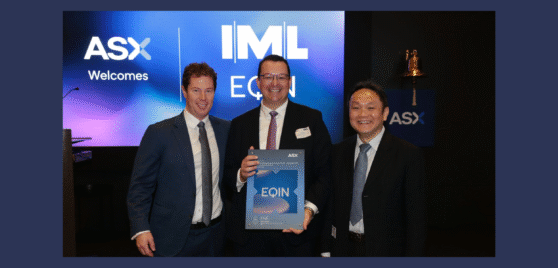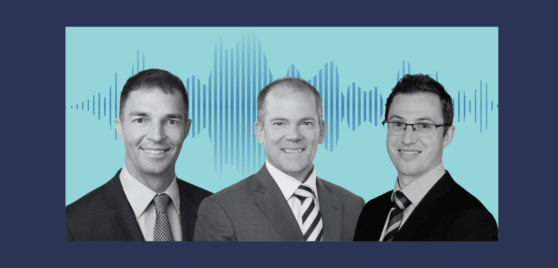Featuring Hugh Giddy and Daniel Moore
LISTEN
READ
In a special series of reporting season podcasts, IML’s portfolio managers give an update on the main themes they are seeing and performance of key stocks. In this podcast IML Portfolio Managers Hugh Giddy and Daniel Moore discuss:
- The health of the consumer
- The performance of banks and commodity prices
- Real Estate Investment Trusts (REITs) and the strength of office versus retail
- Key stocks including:
- Brambles
- Telstra
- The Lottery Corporation
- Aurizon
Follow our podcast, ‘Navigating the Noise’ on Spotify, Apple or Amazon to be notified of new episodes.
 |
 |
 |
Lightly edited transcript
Jason Guthrie: Hello and welcome to Navigating the Noise, a podcast by Natixis Investment Managers Australia, where we bring you insights from our global collective of experts to help you make better investment decisions.
I’m your host, Jason Guthrie, Head of Wholesale, and today we’re holding a couple of special reporting season podcasts where we are joined by the investment team there at IML. Now I was in Sydney actually earlier this week and there were several management teams rolling through the doors. So, I think today’s a very timely update for them to really run us through some of the key themes and how the companies in the portfolios are tracking.
To kick things off, we’re joined by IML’s, large cap team, including portfolio managers, Hugh Giddy and Daniel Moore. Welcome Hugh and welcome Dan. Always great to have you back on the podcast.
Hugh Giddy: Thanks, Jason.
Daniel Moore: Thanks, Jase.
Jason: So gentlemen, I know you’re really in the thick of things with reporting season, so we do appreciate your time today. I think it’s really great for our listeners to get a sense of the market and what you’re hearing from management teams in particular. So it’d be great if we could maybe start by running through some of the key messages and some of the key themes that really caught your attention over the last couple of weeks.
Hugh: Sure. Well I think consumer spending is holding up a bit better than people have expected. You’ve seen very favorable reactions to trading updates post year-end from JB Hi-Fi for example, and you’re seeing the banks’ numbers that they show us about consumer spending that it is still holding up. You are seeing however, a variation in who’s spending more and who’s not spending so much, and that’s very much based on age. Older cohorts without a rental or the prospect of trying to buy a home are more likely to be spending and increasing their spending, whereas younger cohorts are under more pressure. The mortgage belt or the people renting have sometimes had to cut their discretionary spending while spending more on essentials because as we know, essentials like utility bills and insurance have gone up in price. And younger consumers are shown to be dipping into savings to maintain their spending. So just in terms of outlook, there is a bit of pressure on the consumer.
Daniel: And I think it’s fair to say when we caught up with CBA, when we had our meeting with Matt Comyn in our office, he told us the retail results are becoming more widespread. So the good retailers are performing well if they get the offer right, but the lower performing retailers are really struggling. So there is some more divergence in results starting to appear.
Probably just on the banks, everyone likes to know about what’s going on with the banks, the share prices have been strong. The results have been okay, a little bit above consensus, but there’s very little profit growth. In the case of CBA, profits fell a little bit, but I guess the key message the banks were delivering to investors was the outlook for bad debts continues to be favorable. And I guess one of the main reasons for that is everybody has a job pretty much. Unemployment’s very low, but also house prices have gone up a lot over the past four years. So because house prices have gone up so much, LVRs, loan to value ratios, are very low. They’re in the low 40 percent, and pre-COVID they were probably mid-fifties. So the banks collateral position is very strong right now. So even if arrears continue to rise, the bad debts the banks may face should be pretty muted from the mortgage side. So the banks are relatively confident on the shorter term outlook for any rise in bad debts. And then probably the other thing to talk about, Hugh, is probably China.
Hugh: Yes. Yeah, well you’ve seen varied performance in different commodity prices. For example, the gold price has been very strong, but you’ve seen weakness in the iron ore price and you’ve seen weakness in general in lithium prices as people realise that not everyone’s going to buy an electric vehicle, even though the government’s trying to push people to do so for a number of reasons. But the iron ore price is very critical for Australia. Already we’ve seen the treasurer cut budget projections because the iron ore price is now below a hundred US dollars a ton. You’ve got rising port inventories in China and steel companies are losing money, so I think the outlook for iron ore is that it’s unlikely that that price will recover, and we do see a chance that it continues to fall, which has a very pronounced impact on the fortunes of the iron ore miners because their cost of production is very low but can’t be reduced. Whereas if they get a lower iron ore price, their revenues do start reducing quite sharply.
Jason: So a bit of a mix between the different sectors and parts of the economy. Certainly not all rosy, but it certainly feels and sounds like the economy’s holding up relatively well, despite I guess, the continued inflation, particularly services inflation in the high rate environment. I know we’re only partway through earning seasons, I think you were saying two-thirds before, maybe if we turn to the performance of the large cap funds. How are things tracking there, and as an extension of that, maybe touch on some of the key company results in the portfolio?
Daniel: Yeah, Jase, it’s been pretty good so far actually. I mean, as always you have some better results than others, but in general we’re quite happy with how the companies in the portfolio are performing. Probably one of the best ones just reported today, which was Brambles. Their share price is up 10%, which is good. They really had a stellar result. Profits were up 17% for the year, well ahead of expectations. The key highlight really though was the cashflow. The cashflow was up 77% and historically that’s been a bit of an issue for the company, but the management team’s just done a brilliant job tackling that issue by investing a lot in technology, particularly around GPS tracking of their pallets. So they’ve been able to reduce their pallet losses. They’ve automated their pallet repairs and generally improved pallet utilisation. So the cashflow just has been very strong and that’s enabled them to announce a buyback, a $500 million buyback, because the debt’s incredibly low for the business and they’ve increased the dividend payout ratio as well, to 50 to 70%. So a cracking result.
Hugh: Yeah. Another one that we’ve been pleased by is Telstra. Telstra, there was some concern that they wouldn’t be able to continue increasing prices because they said they weren’t going to increase prices by CPI every year, but they’ve announced price increases happening around now, sometimes more than inflation. And what we’re seeing in that business is they continue to grow customers. Their cashflow is strong. They have some small problems in the business or enterprise part of their business, but that’s a much smaller part of the business. The infrastructure business grows very strongly and very reliably, and the mobile business is rock solid.
And the competitors, we’ve seen the competitors’ results. So Optus is making no money on invested capital of $16 billion. They virtually make no money at all. And Vodafone is also barely profitable. So we see that industry as continuing to be one that is favourable for higher prices, more rational behavior in the business, and that is good for Telstra as the market leader who is still adding customers, about half a million extra customers in the year. And they’re investing in inter-city fibre. This is new dedicated fibre to cater to demand for data centers and artificial intelligence. And Microsoft has already committed to be a cornerstone customer taking up some of that fibre. That’s going to run, I think there are 10 routes planned, and I think in quite the near term future will be opening up some of the routes between the major Australian cities.
Jason: They’ve also announced an increase in dividend recently. What is it currently yielding, Telstra?
Daniel: It’s around 5%, fully franked.
Jason: Yeah, pretty solid. Yeah.
Daniel: But the key thing I think, historically, Telstra’s earnings haven’t grown a lot, but if we look at the past three years, they’ve really turned a corner as those NBN headwinds have gone. They’ve grown earnings close to double-digit almost every year for the past three years, and they’re forecasting high single digit growth next year. So the trajectory, the earnings and the trajectory for the dividends we think has really changed from the past, post-NBN. So now we feel really good about the business long term.
Jason: Fantastic. Any others you’d like to cover off and maybe something that hasn’t gone as planned?
Daniel: Yeah, I think Suncorp was a great result. They announced their result yesterday. Profits were up 16% and they’re forecasting further continued growth, so that was another good one for the portfolio.
Hugh: Lottery Corp, very strong profits up 21%. CSL, profit up 15%. But as you say, not everything’s gone completely according to plan.
Jason: Yeah, Dan.
Daniel: So Aurizon, to be honest, the result itself was pretty solid. Profits were up 11%, but it was a little bit below expectation on the back of higher interest costs. So the stock was down 8% on the day. Really, if we look at the underlying performance of the business, we think it’s performing well and we see some really good medium-term growth coming through their land bridging business, which is where they are going to bring goods from Asia through their rail network from Darwin to Adelaide, back through Melbourne and Sydney, rather than people bringing goods via ships, which can get very congested at ports. And they’re talking to four very large perspective potential customers. They’re in contract discussions. So if some of those come off, we see some really good medium term growth for the company.
Hugh: And you’re not paying a lot for the stock now. It’s a very reliable business. They’re able to give guidance. It’s not like it’s very uncertain and it’s trading on about 12 times, which is really appropriate for a business that’s going nowhere rather than a business that has some growth, and they are forecasting growth.
Jason: One of the sectors that’s really been coming up a bit and certainly in the press is REITs, particularly big companies like Dexus. What do you think is playing out in that commercial property market at the moment? How’s the team looking at that given some of the volatility in names on the ASX?
Daniel: Yeah, we’ve looked at the office market really closely, and have for a while just because obviously you like to look at companies where the share prices have fallen quite a bit. The problem we’ve had with office, and continue to have, is the cashflow and while [inaudible 00:13:02].
Hugh: The lack of cashflow more appropriately.
Daniel: That’s true. So if you look at base rents, people are paying, they are going up two or 3%. The problem is the incentives the office trust have to offer tenants to remain a tenant or to win a new tenant. And those incentives can be 30, 40% of the rent. So when an office REIT claims they’re yielding 6%, the cashflow yield’s substantially lower because they’ve got to pay that enormous incentive of 30 or 40%. And then there’s also CapEx that they have to spend on the buildings. They do depreciate over time. So from our perspective, we’ve shied away from office, and Dexus’ result really showed that. I mean the result itself was sort of in line, but the outlook, they had to cut the dividend by 23% and that’s because their original dividend was a hundred percent payout of accounting earnings and the cashflow just wasn’t reflecting those accounting earnings.
So they’ve had to cut the payout ratio substantially, sort of the opposite of Brambles. So we shied away from office. Interestingly, in the REIT sector, the sector that’s doing quite well, which may be a little bit of a surprise, is the retail REITs. They had quite good numbers and the main reason is they can see in the major shopping malls is almost zero. You go through all the major retail landlords, their occupancy’s 99.3% across a number of them. And so they’re actually now starting to get some good rental growth, particularly as they cycle low rents from pre-COVID times. So retail, which has been in the doldrums for a while, the retail shopping centers, is they’re looking quite healthy if we look at the growth rates going forward.
Jason: Well, thank you very much, Hugh. Thanks Dan. Again, really appreciate you jumping on today. It’s a busy time and I know it’s an exciting time for the team there at IML as well. So thank you to our listeners for joining in. If you did enjoy the episode, please do click follow on your podcast platform and tune in again very soon to hear more from our global collective of experts.
Disclaimer
This podcast has been prepared and distributed by Natixis Investment Managers Australia Proprietary Limited, ABN 60 088 786 289, AFSL 246830 and includes information provided by third parties, including Investors Mutual Limited (“IML”) AFSL 229988, the responsible entity and investment manager for the IML Funds.
Although Natixis Investment Managers Australia believes that the material in this podcast is correct, no warranty of accuracy, reliability, or completeness is given, including for information provided by third parties except for liability under statute which cannot be excluded. This material is not personal advice. The material is for general information only and does not take into account your personal objectives, financial situation or needs. You should consider and consult with your professional advisor whether the information is suitable for your circumstances. The opinions expressed in the materials are those are the speakers and may not necessarily be those of Natixis Investment Managers Australia or its affiliate investment managers. Before deciding to acquire or continue to hold an investment in a fund, you should consider the information contained in the product disclosure statement in conjunction with the target market determination, TMD, available at www.stg-imlimited-staging.kinsta.cloud.
Past investment performance is not a reliable indicator of future investment performance and no guarantee of performance, return of capital, or a particular rate of return is provided. Any mention of specific company names, securities or asset classes is strictly for informational purposes only and should not be taken as a recommendation to buy, hold, or sell. Any commentary about specific securities is within the context of the investment strategy for the given portfolio. The material may not be reproduced, distributed, or published in whole or in part without the prior written consent of Natixis Investment Managers Australia. Copyright 2024 Natixis investment Managers Australia. All rights reserved.
INVESTMENT INSIGHTS & PERFORMANCE UPDATES
Subscribe to receive IML’s regular performance updates, invitations to webinars as well as regular insights from IML’s investment team, featured in the Natixis Investment Managers Expert Collective newsletter.
IML marketing in Australia is distributed by Natixis Investment Managers, a related entity. Your subscriber details are being collected by Natixis Investment Managers Australia, on behalf of IML. Please refer to our Privacy Policy. Natixis Investment Managers Australia Pty Limited (ABN 60 088 786 289) (AFSL No. 246830) is authorised to provide financial services to wholesale clients and to provide only general financial product advice to retail clients.





